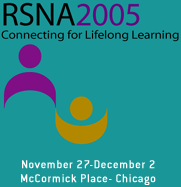
Abstract Archives of the RSNA, 2005
Robert Dinniwell MD, Presenter: Nothing to Disclose
Philip Chan MBBS, Abstract Co-Author: Nothing to Disclose
Michael Milosevic, Abstract Co-Author: Nothing to Disclose
Anthony Fyles, Abstract Co-Author: Nothing to Disclose
David Jaffray, Abstract Co-Author: Nothing to Disclose
Masoom Abbas Haider MD, Abstract Co-Author: Nothing to Disclose
To assess the utility of Magnetic Resonance Imaging (MRI) with an ultra-small superparamagnetic iron oxide that delineates phagocytotic activity within lymph nodes to generate a clinical target volume (CTV) for radiation treatment planning.
A prospective trial was conducted in patients with histologically confirmed prostate or bladder cancer. Pre- and post-contrast axial images were obtained at 3 mm intervals through the pelvis. Ferumoxtran-10 (Combidex®: Advanced Magnetics, Inc, Cambridge, MA) was administered at 2.6 mg Fe/kg on the first day. Manual segmentation and 3D modeling of the pelvic vasculature and lymph nodes was performed from the origin of the inferior mesenteric artery to the ischial tuberosities. Lymph node frequency and location relative to vascular segments was analyzed. Nodes were ascertained to have metastases using previously demonstrated criteria (Harisinghani et al. NEJM 2003;348:2491-9).
40 patients were enrolled (8 bladder and 32 prostate carcinomas). Median age was 68 years (47-81). There were: 12 T1c, 6 T2a, 8 T2b, 5 T3a and 1 T3b prostate tumors with Gleason scores ranging from 6 to 9 (median 7) and a median PSA of 11.56 ng/mL (3.41-90.40). In those with prostate cancer, 39 malignant nodes were identified in the following locations: obturator fossa (7); internal iliac (3); external iliac (11); common iliac (5); aortic/aortocaval (3); pararectal (6); and sacral (4).
There were: 1 T1; 3 T2; 3 T3 and 1 T4A bladder tumors. The median number of nodes excised during cystectomy was 29 (range 21 to 47). Metastases were identified in the following locations or vascular segments: perivesicle (1); internal iliac (8); external iliac (6); common iliac (2); aortic/aortocaval (3); and pararectal (2).
For all patients, on post-contrast MRI imaging, a median of 27 (range 18 to 39) nodes was identified. The maximum distance of the lymph nodes from the closest vessel was between 2.5 and 30 mm, with a mean distance of 7.5 mm.
The identification of lymph nodes at risk of occult metastases with ferumoxtran-10 may facilitate the delineation of a nodal CTV for IMRT treatment planning in addition to enabling dose escalation of macroscopic nodal disease.
Dinniwell, R,
Chan, P,
Milosevic, M,
Fyles, A,
Jaffray, D,
Haider, M,
Nodal Mapping Using Magnetic Resonance Lymphography with Ferumoxtran-10 for Radiotherapy Treatment Planning of Bladder and Prostate Cancers. Radiological Society of North America 2005 Scientific Assembly and Annual Meeting, November 27 - December 2, 2005 ,Chicago IL.
http://archive.rsna.org/2005/4407240.html

